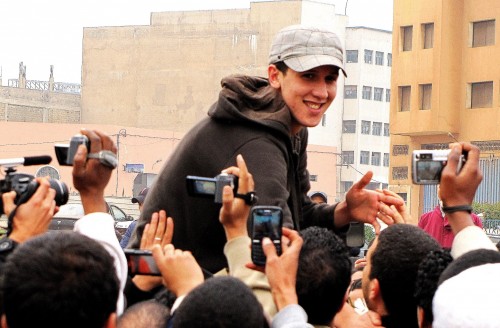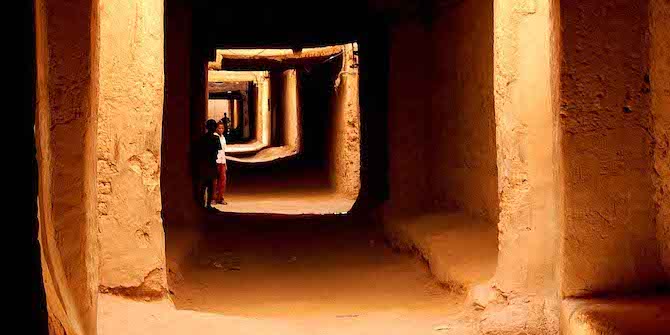by Cristina Moreno Almeida
This article is part of a 7-part series assessing the prospects and challenges for the study of North Africa in the wake of the Arab Spring.

In December 2010, the young Hamada Ben Amor aka El General, a fairly unknown Tunisian rapper until then, was arrested for a song and music video he had posted online condemning the Tunisian president Ben Ali. Months later, in September 2011, Mouad Belghouat aka L7a9ed (or LHaqed), another novel young rapper, was arrested in Morocco during a demonstration organised by the pro-democracy 20 February Movement. The movement, initiated in the midst of the region’s uprisings earlier that year, aimed at fighting socio-economic inequalities, systemic oppression and corruption. LHaqed was arrested again on 11 May 2012, this time accused of using offensive images showing the police as donkeys in a YouTube video for the song ‘Klab Dawla‘ [Dogs of the State] (dating from 2010). While journalists and academics had until then paid little attention to Tunisian and Moroccan hip hop as compared to the Palestinian hip hop scene, articles on these incarcerated rappers and the role of rap as the soundtrack of the ‘Arab Spring’ protests soon boomed.
As soon as 11 January 2011, the French newspaper Le Monde published an article called ‘Le rap, porte-parole de la jeunesse Tunisienne‘ [Rap, the spokesperson of Tunisian youth]. The article claimed that Tunisian rap groups such as Armada Bizerta or rapper El General are mirrors for the social and political situation in Tunisia under Ben Ali’s regime. Rap, supposedly, gathers young Tunisian voices to express their feelings of discontent. However the article gave a very cursory examination of the role of rap within the Tunisian local cultural scene. Firstly, it assumed the dominant role of rap among Tunisian youth (how could Tunisian youngsters not like rap!) and secondly, it presupposed that the genre was purely concerned with State Politics (with a capital P). Audiences’ preferences, differences over aesthetics, or the mere fact that rap may not have been so popular in Tunisia were disregarded to make way for the framework of the ‘revolution’.
Articles published in international publications thereafter, including Time (15 February 2011), Time Magazine (17 February 2011), The Guardian (27 February 2011), Muftah (28 May 2011), BBC News (24 July 2011), The Nation (27 August 2011) all promoted the idea that rap was the soundtrack of the Middle East and North Africa uprisings, describing it as the music of anger and frustration. Rap in the MENA region was framed in terms such as the article from Time Magazine entitled: ‘Rage, Rap and Revolution: Inside the Arab Youth Quake.’ The portrayal of an enraged Arab youth was reiterated by The Guardian: ‘From Fear to Fury: How the Arab World Found Its Voice.’ In the midst of these times of anger, journalists portrayed incarcerated rappers not only as figureheads, but heroes of the oppressed. Such was the case with LHaqed, praised for being ‘one of the best Arab world rappers’ in an opinion piece for Al-Jazeera English, a ‘political rap star’ (National Public Radio, 6 January 2012) or a ‘poet’ (France 24, 4 April 2012).
Some scholars have joined journalists in turning rap music into some kind of miracle-culture, able to unite youth across the region as they conspire against oppressive regimes. In their book Democracy’s Fourth Wave?: Digital Media and the Arab Spring, Philip N. Howard and Muzammil M. Hussain make an isolated claim on the role played by hip hop in the uprising asserting that ‘soundtracks to the revolution produced by digital hip hop artists from Libya and Algeria inspired young citizens and earned artists jail time’. In the same vein, in an article published in 2013, Ilyana Ovshieva claimed the connection between rap music in Tunisia and the narrative of liberation by stating that ‘Rap… emerged as a one of the focal modes of youthful self-expression during the epochal uprising…’ Correspondingly, Nouri Gana argues in Rap and Revolt in the Arab World that ‘In a world that is currently shot through with insurrection and revolt, rap music is … a part and parcel of the exponential curve of change sweeping across, among others, Tunisia, Egypt, Libya, Yemen, Bahrain, Syria, and Morocco…’
As significant as rap music may be in some of these countries, rap or any other cultural production for that matter cannot be dealt with as a homogenous phenomenon across national borders that were inherited from colonial rule, as in the MENA region. Not all young people in the region like or listen to rap, and certainly not all rappers have the same political opinion and messages, just as not every young person is interested in capital-P politics. The meanings and purposes of cultural production are never simple and yet these accounts present a music scene hijacked by a series of political events in a precise moment in time. In its aftermath, stories of rappers in Tunisia and Morocco are almost totally absent from international newspapers and academic works (with of course, some exceptions), now that the Arab Spring momentum has faded away.
Reduced and oversimplified accounts of youth culture encourage, on the one hand, the perpetuation of the image of the ‘angry Arab youth’, constantly protesting against oppressive regimes; and on the other hand, a lack of interest in cultural aesthetics and other frameworks, political or not, that young people create, in favour of a focus on overpoliticised cultural production. In this sense, rap music in Morocco and Tunisia is no different from narratives that consider ‘global rap’ to be a political genre or ‘resistance music’. In the case of the MENA region, ‘political’ and ‘resistance’ are interpreted in a very limited sense that does not allow rappers to be political or resistant in ways outside capital-P politics and protest culture. Yet rappers in Morocco and Tunisia have for many years been developing sounds, beats, rhymes, flows and themes that go beyond the Arab Spring, even those, incarcerated or not, who have decided to engage with capital-P politics in some of their songs. Regardless, in spite of the hype around the uprisings, cultural struggle for equality and justice did not start or finish with the Arab Spring. As one well-known Moroccan rapper claimed in a freestyle posted on YouTube in February 2013, two years after the 20 February demonstrations, ‘Ana machi 20 Febrayer, ana l3am kamel‘, that is, ‘I’m not 20 February, I’m the whole year round’.
 Cristina Moreno Almeida is British Academy Postdoctoral Fellow in the Department of Digital Humanities, King’s College London. She is an active member of several international research groups based in the UK, Morocco and Spain. She is the author of the forthcoming Rap Beyond Resistance: Staging Power in Contemporary Morocco (Palgrave Macmillan, 2017). She tweets at @CrisMorAlm
Cristina Moreno Almeida is British Academy Postdoctoral Fellow in the Department of Digital Humanities, King’s College London. She is an active member of several international research groups based in the UK, Morocco and Spain. She is the author of the forthcoming Rap Beyond Resistance: Staging Power in Contemporary Morocco (Palgrave Macmillan, 2017). She tweets at @CrisMorAlm
In this series:
- The Arab Spring and the Academy: Studying North Africa in the Wake of the Protest by Jonathan Hill
- An Uprising in the Social Sciences? The Study of Middle East Politics in Transformation by Florian Kohstall
- Studying Libya today: Exploring the past to understand the present and shape future research agendas by Anna Baldinetti
- The Politics-Security Nexus in Post-Revolutionary Tunisia by Francesco Milan
- Algeria: Changing behind a Façade of Stalemate by Rasmus Alenius Boserup
- Refugees and ‘Host Communities’ Facing Gender-Based Violence around Mbera Camp, Mauritania by Olga Martín González






